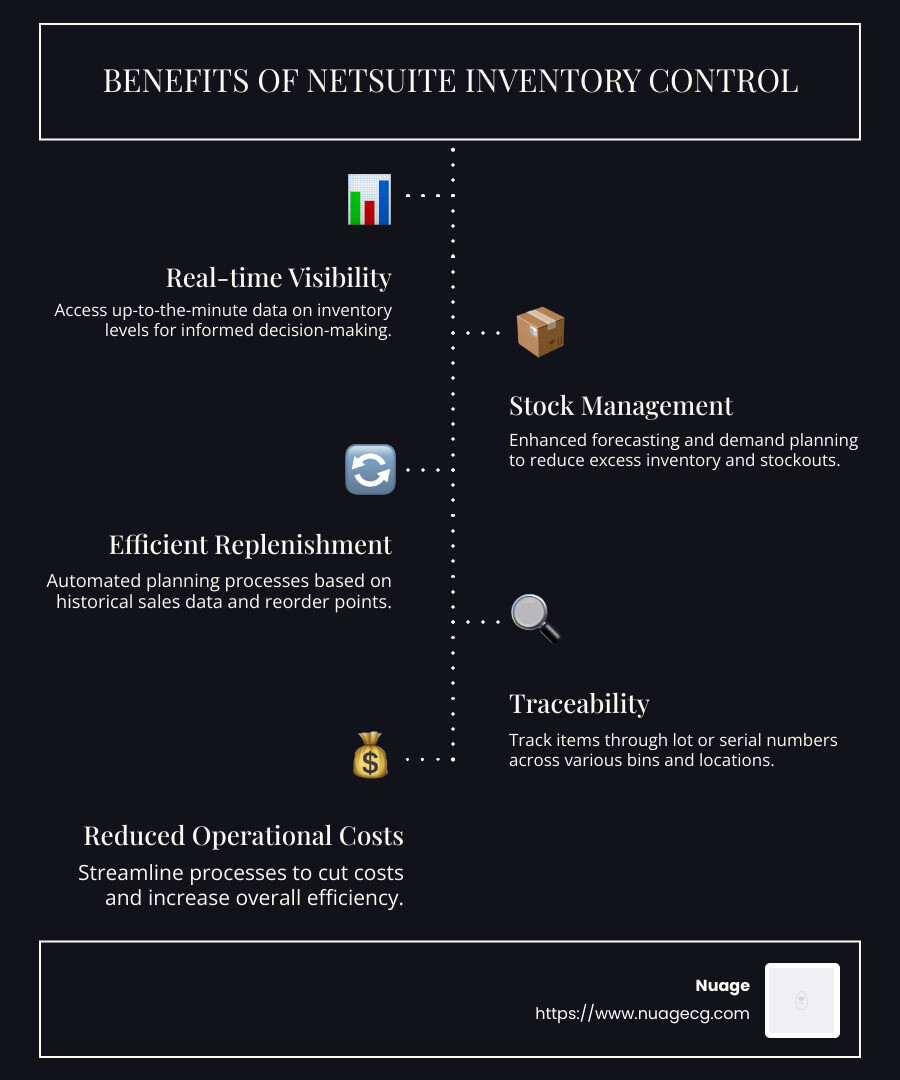NetSuite inventory control is a transformative solution for businesses aiming to optimize their inventory processes and enhance operational efficiency. By integrating this powerful tool, companies can benefit from real-time inventory visibility, reduced operational costs, and improved stock management across multiple locations.
Key points about NetSuite inventory control:
- Real-time Visibility: Provides up-to-the-minute data on inventory levels, aiding in informed decision-making.
- Stock Management: Offers tools for better forecasting and demand planning, minimizing excess inventory and stockouts.
- Efficient Replenishment: Automates planning processes based on historical sales data and predefined reorder points.
- Traceability: Easily tracks items through lot or serial numbers and manages inventory across various bins and locations.
Incorporating NetSuite inventory control into your business strategy can revolutionize your supply chain management, reduce losses due to overstock or stockouts, and drive profitability. For more insights, visit our NetSuite page and explore how we can assist you in leveraging this technology.
I’m Louis Balla, a partner at Nuage and a specialist in NetSuite and ERP solutions. With over 15 years of digital change and supply chain experience, I’ve witnessed the impact of implementing effective NetSuite inventory control strategies for businesses seeking growth and efficiency.

Find more about NetSuite inventory control:
What is NetSuite Inventory Control?
NetSuite Inventory Control is a comprehensive system designed to streamline and optimize inventory management for businesses of all sizes. It offers a suite of features that automate and improve various aspects of inventory control, providing a real-time view of stock levels and facilitating more informed decision-making.
Key Features
- Real-Time Visibility:
- With NetSuite, businesses gain access to up-to-the-minute data on inventory levels, movement, and status. This transparency ensures that decision-makers can act promptly and accurately, reducing the risk of stockouts or overstocking.

- Automation:
- NetSuite automates many manual inventory processes, saving time and reducing errors. Tasks such as reorder point calculations, stock level adjustments, and inventory transfers are streamlined, allowing staff to focus on more strategic activities.
- Multi-Location Management:
- Manage inventory across multiple locations effortlessly. NetSuite allows businesses to track stock in various warehouses or stores, ensuring that inventory is always in the right place at the right time.
Benefits
- Efficiency Gains:
- By automating routine tasks and providing a real-time view of inventory, NetSuite reduces the workload on staff and minimizes human error. This leads to faster operations and more accurate inventory management.
- Cost Reduction:
- Improved stock management helps reduce carrying costs and minimizes losses due to excess or insufficient inventory. Businesses can optimize their inventory levels to match demand more closely, leading to cost savings.
- Improved Decision-Making:
- Access to real-time data and advanced analytics tools empowers businesses to make data-driven decisions. This includes setting optimal reorder points, forecasting demand, and planning inventory purchases.
Real-Time View and Automation
NetSuite‘s real-time view of inventory is a game-changer for businesses. It allows for immediate insights into stock levels and movements, enabling quick responses to changes in demand or supply chain disruptions.
Automation further improves this capability by reducing the need for manual intervention. For example, the system can automatically generate purchase orders when stock levels fall below a certain threshold, ensuring that inventory is replenished promptly without manual oversight.
In summary, NetSuite Inventory Control provides businesses with the tools they need to manage inventory efficiently and effectively. By leveraging real-time data and automation, companies can optimize their inventory processes, reduce costs, and improve overall operational efficiency.
For more information on how NetSuite Inventory Control can transform your business, visit Nuage’s NetSuite page.
Key Features of NetSuite Inventory Control
Multi-location Fulfillment
Managing inventory across multiple locations can be a logistical challenge. NetSuite Inventory Control simplifies this with predefined rules that automatically direct orders to the location where all items are available. This minimizes multiple shipments, reducing shipping costs and delivery times.
Stock levels are monitored in real time across all locations, providing a comprehensive view of inventory. This visibility allows businesses to proactively transfer inventory between locations as needed. Inventory transfer forms facilitate the movement of goods, ensuring that stock is in the right place at the right time.
Replenishment
Maintaining optimal inventory levels is crucial for customer satisfaction and profitability. NetSuite offers demand-based replenishment, using historical sales data and seasonality trends to set accurate reorder points. This ensures that inventory is replenished before stockouts occur, without overstocking.
The system generates alerts and tasks automatically, notifying purchase managers when it’s time to reorder. This automation reduces the need for manual monitoring and helps maintain a balance between supply and demand.
Cycle Counting
Regular cycle counting is an essential practice for maintaining inventory accuracy. NetSuite’s Smart Count feature automates this process, allowing for efficient and accurate counts. It can even be conducted using a mobile device, integrating seamlessly into daily operations without disrupting workflow.
By focusing on specific SKUs rather than the entire inventory, businesses can maintain high levels of accuracy and reduce the need for full physical counts. This not only saves time but also helps in identifying discrepancies early.
Traceability
For businesses dealing with perishable or regulated goods, traceability is key. NetSuite supports lot and serial tracing, allowing companies to track items from manufacturer to end-user. This is crucial for quality control and regulatory compliance.
Bin management further improves traceability by organizing inventory within the warehouse, making it easy to locate and manage stock. This system supports a merchandise hierarchy, providing a structured view of inventory that aids in both tracking and fulfillment strategies.
Item Visibility
NetSuite’s Item 360 Dashboard offers a centralized information hub, presenting key performance indicators (KPIs) and real-time data in a user-friendly format. This dashboard gives businesses a comprehensive view of their inventory, helping them to make informed decisions quickly.
The centralized nature of the dashboard ensures that all stakeholders have access to the same information, promoting consistent decision-making across the organization.
By leveraging these features, businesses can optimize their inventory management processes, ensuring efficiency, accuracy, and cost-effectiveness. For a more detailed exploration of how NetSuite Inventory Control can benefit your operations, visit Nuage’s NetSuite page.
How to Implement NetSuite Inventory Control
Setting up NetSuite Inventory Control effectively can transform your inventory management operations. Here’s a step-by-step guide to help you get started:
Setup and Configuration
- Initial Setup: Start by accessing your NetSuite dashboard. Steer to the Inventory Management module to begin setting up your inventory control system. Ensure you have the necessary permissions to configure settings.
- Enable Essential Features: Activate critical features like the Inventory Count and Bin Management. These tools improve your ability to track and manage inventory efficiently. Enabling the Advanced Bin/Numbered Inventory Management feature can further support serialized or lot-numbered items.
- Customize Item Records: Define unique characteristics for each inventory item. This includes units of measure, costing methods (like FIFO or LIFO), and replenishment methods. Configuring these details accurately ensures seamless inventory tracking and management.
- Set Reorder Points: Establish reorder points and preferred stock levels for each item. This helps automate the replenishment process, ensuring you’re alerted before stockouts occur.
Multi-Location Setup
- Configure Locations: If your business operates in multiple locations, configure each one within NetSuite. This allows you to track inventory levels and movements across all sites.
- Inventory Distribution: Use the Inventory Distribution forms to allocate unallocated inventory to specific locations. This step is crucial for businesses with a Multi-Location Inventory setup.
- Inventory Transfers: Use the Inventory Transfer and Transfer Order forms to move stock between locations. This ensures that inventory is available where it’s needed most, reducing shipping costs and delivery times.
- Intercompany Transfers: For businesses using NetSuite OneWorld accounts, set up Intercompany Transfer Orders to move inventory between subsidiaries. This feature is essential for global operations, ensuring seamless stock movements across international locations.
Enabling Advanced Features
- Smart Count for Cycle Counting: Activate the Smart Count feature to automate cycle counting. This tool allows for efficient inventory audits, helping maintain accuracy without disrupting daily operations.
- Traceability Tools: Implement lot and serial tracing, along with bin management, to improve traceability. These features are vital for quality control and regulatory compliance.
- Item Visibility with Item 360 Dashboard: Leverage the Item 360 Dashboard for a centralized view of your inventory. This tool provides real-time data and KPIs, aiding in informed decision-making.
By following these steps, you can effectively implement NetSuite Inventory Control to optimize your inventory processes. For more insights on leveraging NetSuite’s capabilities, explore Nuage’s NetSuite page.
Best Practices for NetSuite Inventory Control
Automate Inventory Tracking
One of the key advantages of NetSuite Inventory Control is the ability to automate inventory tracking. This reduces manual processes and helps maintain real-time visibility of inventory across multiple locations. By automating these tasks, businesses can minimize human error and ensure accurate, up-to-date inventory data. This is crucial for making informed decisions and responding swiftly to changes in demand.
Optimize Inventory Levels
Maintaining optimal inventory levels is vital to avoid stockouts and minimize excess stock. NetSuite provides tools to help you make data-driven decisions by analyzing historical data and demand patterns. You can set reorder points and preferred stock levels, ensuring you never run out of essential items or overstock on slow-moving products. Leveraging these features helps businesses keep inventory costs low while maximizing sales opportunities.
Efficient Replenishment Strategies
NetSuite’s demand-based replenishment takes into account seasonality, lead time, and reorder points. This allows businesses to plan inventory purchases more effectively, ensuring they have the right amount of stock on hand to meet customer demand. By analyzing sales trends and supplier lead times, you can adjust your replenishment strategies to align with market fluctuations, reducing the risk of overstocking or understocking.
Regular Cycle Counting
Implementing regular cycle counting is crucial for maintaining inventory accuracy. With NetSuite’s Smart Count feature, businesses can automate cycle counting and perform inventory adjustments as needed. This feature allows for mobile counting, making it easier for staff to conduct counts without disrupting daily operations. By integrating cycle counting into routine tasks, companies can ensure their inventory records are always accurate and up-to-date.
Improve Traceability
Enhancing traceability is essential for quality control and regulatory compliance. NetSuite offers lot and serial number tracking, along with bin management, to provide detailed insights into the movement and status of inventory items. These tools enable businesses to trace products throughout the supply chain, ensuring accountability and transparency. Additionally, effective fulfillment strategies can be developed by understanding the precise location and status of each item in the inventory.
By implementing these best practices, businesses can fully leverage the capabilities of NetSuite Inventory Control to streamline their inventory management processes. This leads directly into the next section, where we will address some frequently asked questions about using NetSuite for inventory management.
Frequently Asked Questions about NetSuite Inventory Control
Does NetSuite have an inventory management system?
Yes, NetSuite offers a comprehensive inventory management system that helps businesses efficiently manage their stock. This system is designed to provide real-time visibility and control over inventory levels, which is crucial for maintaining smooth operations. With features like multi-location fulfillment, demand-based replenishment, and cycle counting, NetSuite ensures that businesses can optimize their inventory processes and meet customer demands effectively. For more details on how NetSuite can transform your inventory management, visit our NetSuite page.
How to do inventory counts in NetSuite?
Conducting inventory counts in NetSuite is straightforward and can be done using the Smart Count feature. This tool allows for automated cycle counting, making it easier to maintain inventory accuracy without disrupting daily operations. Here’s a simple process:
- Schedule Cycle Counts: Set up regular cycle counts based on your business needs.
- Use Mobile Devices: Leverage mobile devices to perform counts, ensuring flexibility and efficiency.
- Adjust Inventory: Make necessary inventory adjustments based on the count results to reconcile any discrepancies.
By following these steps, businesses can ensure their inventory records are accurate and up-to-date, which is essential for effective inventory management. Learn more about inventory counting and other advanced features on our NetSuite page.
What is inventory detail in NetSuite?
Inventory detail in NetSuite refers to the comprehensive information available for each inventory item. This includes data such as:
- Lot and Serial Numbers: Track specific batches or individual items for quality control and traceability.
- Bin Management: Organize inventory within locations for efficient storage and retrieval.
- Inventory Status: Monitor the condition and availability of items to ensure they are ready for sale or use.
These details provide businesses with a granular view of their inventory, enabling better decision-making and operational efficiency. For a deeper dive into how inventory detail can benefit your business, explore our NetSuite page.
By addressing these common questions, we hope to clarify how NetSuite Inventory Control can improve your inventory management processes. Next, we’ll summarize the key benefits and how Nuage can support your business in leveraging these powerful tools.
Conclusion
In summary, NetSuite Inventory Control offers a powerful solution for businesses looking to streamline their inventory management. With features like real-time visibility, multi-location fulfillment, and automated cycle counting, NetSuite ensures that your inventory processes are both efficient and accurate. This not only helps in meeting customer demands but also minimizes costs associated with excess stock or stockouts.
The benefits of using NetSuite are clear. It provides a comprehensive view of your inventory, allowing for data-driven decisions that can optimize stock levels and improve overall business operations. The system’s ability to handle complex tasks, such as traceability and demand-based replenishment, makes it an invaluable asset for businesses of all sizes.
At Nuage, we specialize in helping companies implement and support their NetSuite systems. With over 20 years of experience in the ERP industry, we are well-equipped to guide your business through the digital change journey. Our expertise in the manufacturing and food and beverage sectors ensures that we understand the unique challenges your business faces and can tailor solutions to meet your specific needs.
If you’re ready to take your inventory management to the next level, we invite you to learn more about how we can assist you. Visit our NetSuite page for more information, or contact us directly to discuss how we can support your business goals. Our team is here to provide the guidance and expertise you need to succeed in today’s competitive market.


